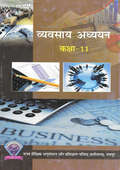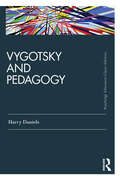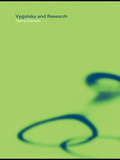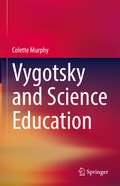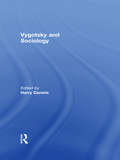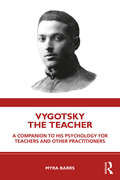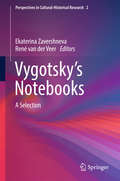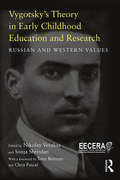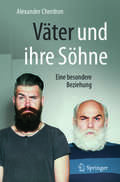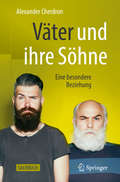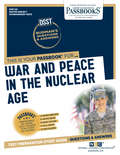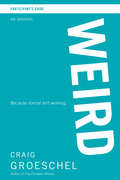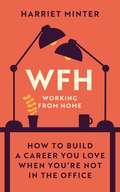- Table View
- List View
Vyavsay Adhyayan class 11 - S.C.E.R.T Raipur Chhattisgarh Board: व्यवसाय अध्ययन कक्षा 11 - एस.सी.ई.आर.टी. रायपुर - छत्तीसगढ़ बोर्ड
by Raipur C. G. Rajya Shaikshik Anusandhan Aur Prashikshan Parishadव्यवसाय अध्ययन 11 वीं कक्षा का राज्य शैक्षिक अनुसंधान और प्रशिक्षण परिषद् छत्तीसगढ़ रायपुर ने पुस्तक हिंदी भाषा में प्रकाशित किया गया है। यह पाठ्यपुस्तक व्यावसायिक वातावरण की एक अच्छी जानकारी देने की अपेक्षा करती है। एक प्रबन्धक को व्यवसाय की जटिल, गतिशील स्थितियों का विश्लेषण करना पड़ता है। विषय-वस्तु को अधिक समृद्ध बनाने के लिए व्यावसायिक पत्र-पत्रिकाओं और लेखों के उद्धरणों को अतिरिक्त रूप से कोष्ठकों में जोड़ा गया है। इससे विद्यार्थियों को प्रोत्साहन मिलता है कि वें व्यवसाय की प्रतिक्रियाओं का अवलोकन करें एवं स्वयं खोज करने का प्रयास करें कि व्यावसायिक संगठनों में क्या हो रहा है। यह भी अपेक्षा की जाती है कि इस दौरान वे पुस्तकालय, समाचार-पत्रों, व्यवसायोन्मुख दूरदर्शन कार्यक्रमों और इन्टरनेट के द्वारा आधुनिक जानकारी प्राप्त करेंगे। विभिन्न प्रकार के प्रश्न एवं केस समस्याएँ प्रस्तावित की गई हैं जिससे वे विषय के ज्ञान प्रयोग द्वारा वास्तविक व्यावसायिक स्थितियों को जान सकें।
Vyavsay Adhyayan class 12 - RBSE Board: व्यवसाय अध्ययन कक्षा 12 - आरबीएसई बोर्ड
by Madhyamik Shiksha Board Rajasthan Ajmerव्यवसाय अध्ययन कक्षा-12 के विद्यार्थियों के लिए लिखी गयी पाठ्य पुस्तक प्रस्तुत करते हुए प्रसन्नता है। पुस्तक लेखन के समय हमारे केन्द्र में मुख्य रूप से वे विद्यार्थी रहे हैं जो वाणिज्यिक दृष्टिकोण से व्यावसायिक घटनाओं के संबंध में अवधारणात्मक समझ विकसित करने हेतु अध्ययन कर रहे हैं।
Vyavsayik Arthashastra class 11 - MP Board: व्यवासायिक अर्थशास्त्र कक्षा 11 - एमपी बोर्ड
by Madhyamik Shiksha Mandal Madhya Pradesh BhopalVyavshik Arthshastra text book for 11th standard from Madhyamik Shiksha Mandal Madhya Pradesh Bhopal in Hindi.
Vyavsayik Arthashastra class 11 - MP Board: व्यवासायिक अर्थशास्त्र कक्षा 11 - एमपी बोर्ड
by Madhyamik Shiksha Mandal Madhya Pradesh BhopalBusiness Economics (MPTBC) text book for 11 th standard from Madhyamik Shiksha Mandal Madhya Pradesh Bhopal in Hindi.
Vyavsayik Arthashastra class 12 - MP Board: व्यवासायिक अर्थशास्त्र कक्षा 12 - एमपी बोर्ड
by Madhya Pradesh Rajya Shiksha MandalVyavsayik Arthashastra text book for 12th standard from Madhya pradesh rajya shikha mandal in Hindi.
Vygotsky and Education: Instructional Implications and Applications of Sociohistorical Psychology
by Luis C. MollThe seminal work of Russian theorist Lev Vygotsky (1896–1934) has exerted a deep influence on psychology over the past 30 years. Vygotsky was an educator turned psychologist, and his writings clearly reflected his pedagogical concerns. For Vygotsky, schools and other informal educational situations represent the best cultural laboratories to study thinking. He emphasized the social organization of instruction, writing about the 'unique form of cooperation between the child and the adult that is the central element of the educational process'. Vygotsky's emphasis on the social context of thinking represents the reorganization of a key social system and associated modes of discourse, with potential consequences for developing new forms of thinking. This volume is devoted to analyzing Vygotsky's ideas as a means of bringing to light the relevance of his concepts to education. What does Vygotsky's approach have to offer education? Distinguished scholars from various countries and representing several disciplines discuss the essence and significance of Vygotsky's work, analyze the educational implications of his thoughts, and present applications in practice, addressing educational issues such as school organization, teacher training, educational achievement, literacy learning and development, uses of technology, community-based education, and special education.
Vygotsky and Pedagogy
by Harry DanielsThe Routledge Classic Edition of Daniels’ influential 2001 text Vygotsky and Pedagogy explores the growing interest in Vygotsky and the pedagogic implications of the body of work that is developing under the influence of his theories. With a new preface from Harry Daniels this book explores the growing interest in Vygotsky and the pedagogic implications of the body of work that is developing under the influence of his theories. It provides an overview of the ways in which the original writing has been extended and identifies areas for future development. The author considers how these developments are creating new and important possibilities for the practices of teaching and learning in school and beyond, and illustrates how Vygotskian theory can be applied in the classroom. The book is intended for students and academics in education and the social sciences and will be of interest to all those who wish to develop an analysis of pedagogic practice within and beyond the field of education.
Vygotsky and Research
by Harry DanielsThis book provides readers with an overview of the implications for research of the theoretical work which acknowledges a debt to the writings of L.S. Vygotsky. A concise introduction to Vygotsky’s original thesis and discussions on his approach to research methods is given; this is followed by an exploration of the research practices which have arisen in fields developed on the basis of his original thesis. These include: Socio-cultural studies with a focus on mediated action; Distributed Cognition, Situated Cognition and Activity Theory. To aid understanding, chapters devoted to each area will provide excellent accounts of specific studies which illustrate the underlying methodological principles and the specific methods which are being deployed. In each case assumptions and limitations are discussed. The book concludes with some proposals for future developments at both methodological and conceptual levels.
Vygotsky and Science Education
by Colette MurphyThis book highlights those aspects of Vygotskian theory which are most cogent to Science Education, including the Zone of Proximal Development (ZPD), concept development, play and imagination. Whilst these and other Vygotskian constructs apply to both research and practice in all forms of Science Education, this book employs a specific and critical focus on one or two key concepts for each context. Thus play and imagination are explored in depth in the chapter on science in early childhood learning, the ZPD is considered in depth in the primary school science chapter, and concept development in the secondary-level chapter. Chapters on higher education science learning and teaching, science teacher education, informal science learning, science education research, and the scientific endeavour itself draws on those aspects of Vygotskian theory which relate most closely. This book makes an important contribution to Vygotskian theory. Never before has it been applied so widely and comprehensively to the field of science and STEM education. The book is intended for students and academics in science and STEM education and the social sciences. It is also of interest to Vygotsky scholars and those involved in the analysis of pedagogic practice within and beyond science and STEM education.
Vygotsky and Sociology
by Harry DanielsBuilding on earlier publications by Harry Daniels, Vygotsky and Sociology provides readers with an overview of the implications for research of the theoretical work which acknowledges a debt to the writings of L.S. Vygotsky and sociologists whose work echoes his sociogenetic commitments, particularly Basil Bernstein. It provides a variety of views on the ways in which these two, conceptually linked, bodies of work can be brought together in theoretical frameworks which give new possibilities for empirical work. This book has two aims. First, to expand and enrich the Vygotskian theoretical framework; second, to illustrate the utility of such enhanced sociological imaginations and how they may be of value in researching learning in institutions and classrooms. It includes contributions from long-established writers in education, psychology and sociology, as well as relatively recent contributors to the theoretical debates and the body of research to which it has given rise, presenting their own arguments and justifications for forging links between particular theoretical traditions and, in some cases, applying new insights to obdurate empirical questions. Chapters include: Curriculum and pedagogy in the sociology of education; some lessons from comparing Durkheim and Vygotsky Dialectics, politics and contemporary cultural-historical research, exemplified through Marx and Vygotsky Sixth sense, second nature and other cultural ways of making sense of our surroundings: Vygotsky, Bernstein, and the languaged body Negotiating pedagogic dilemmas in non-traditional educational contexts Boys, skills and class: educational failure or community survival? Insights from Vygotsky and Bernstein. Vygotsky and Sociology is an essential text for students and academics in the social sciences (particularly sociology and psychology), student teachers, teacher educators and researchers as well as educational professionals.
Vygotsky for Educators
by Yuriy V. KarpovLev Vygotsky's approach to children's learning and development centers on adult mediation: adults engage children in age-appropriate activities and promote in this context the development of new motives and tools for thinking, problem solving, and self-regulation. Although this approach has earned widespread recognition in the global scientific community, English-speaking educators remain relatively unfamiliar with its contemporary elaborations for practical application. Yuriy V. Karpov offers the first comprehensive English introduction to contemporary elaborations of Vygotsky's ideas and their practical applications from birth through adolescence. He demonstrates the advantages of the Vygotskian approach over both traditional and constructivist education. This volume will prove an invaluable resource for educators and students in teacher education programs, as well as for everyone interested in educational and developmental psychology.
Vygotsky the Teacher: A Companion to his Psychology for Teachers and Other Practitioners
by Myra BarrsThis highly accessible guide to the varied aspects of Vygotsky’s psychology emphasises his abiding interest in education. Vygotsky was a teacher, a researcher and educational psychologist who worked in special needs education, and his interest in pedagogy was fundamental to all his work. Vygotsky the Teacher analyses and discusses the full range of his ideas and their far-reaching educational implications. Drawing on new work, research and fresh translations, this unique text foregrounds key Vygotskian perspectives on play, imagination and creativity, poetry, literature and drama, the emotions, and the role of language in the development of thought. It explains the textual issues surrounding Vygotsky’s publications that have, until recently, obscured some of the theoretical links between his ideas. It underlines Vygotsky’s determination to create a psychology that is capable of explaining all aspects of the development of mind. Vygotsky the Teacher is essential reading for students on education and psychology courses at all levels, and for all practitioners wanting to know more about Vygotsky’s theories and their roots in research and practice. It offers a unique road map of his work, connecting its different aspects, and placing them in the context of his life and the times in which he lived.
Vygotsky's Educational Theory in Cultural Context
by Alex Kozulin Boris Gindis Vladimir S. Ageyev Suzanne M. MillerInnovative ideas in educational psychology, learning, and instruction, originally formulated by Russian psychologist and educator Lev Vygotsky, are currently enjoying unprecedented popularity in the U. S. , Latin America, Europe, and Russia. An international team of scholarly contributors provides comprehensive coverage of all the main concepts of Vygotsky's sociocultural theory. They emphasize its importance for the understanding of child development, and propose specific classroom applications.
Vygotsky’s Notebooks
by René van der Veer Еkaterina ZavershnevaThis book consists of previously unpublished manuscripts by Vygotsky found in the first systematic study of Vygotsky’s family archive. The notebooks and scientific diaries gathered in this volume represent all periods of Vygotsky’s scientific life, beginning with the earliest manuscript, entitled The tragicomedy of strivings (1912), and ending with his last note, entitled Pro domo sua (1934), written shortly before his death. The notes reveal unknown aspects of the eminent psychologist’s personality, show his aspirations and interests, and allow us to gain insights into the development of his thinking and its internal dynamics. Several texts reflect the plans that Vygotsky was unable to realize during his lifetime, such as the creation of a theory of emotions and a theory of consciousness, others reveal Vygotsky’s involvement in activities that were previously unknown, and still others provide outlines of papers and lectures. The notes are presented in chronological order, preceded by brief introductions and accompanied by an extensive set of notes. The result is a book that allows us to obtain a much deeper understanding of Vygotsky’s innovative ideas.
Vygotsky’s Theory in Early Childhood Education and Research: Russian and Western Values
by Nikolay Veraksa Sonja SheridanDrawing upon in-depth analyses of Lev Vygotsky’s theories of early childhood and investigating the ways in which his ideas are reflected in contemporary educational settings, this book brings into sharp relief the numerous opportunities for preschool learning and development afforded by Vygotskian approaches. Discussion of recent developments in the understanding and implementation of Vygotsky’s ideas in Western and Russian contexts facilitates comparison, and provides readers with fresh impetus to integrate elements into their own practice. Chapters are clearly structured and address the multitude of aspects touched upon by Vygotsky, including cognitive development, communication and interaction, play, literacy and the quality of preschool settings. Providing a comprehensive exploration of current stances on Vygotsky's ideas in diverse cultural-historical contexts, Vygotsky's Theory in Early Childhood Education and Research will be of interest to researchers, practitioners, educators and politicians involved in early years education.
Väter und ihre Söhne
by Alexander CherdronDas Buch widmet sich der Vater-Sohn-Beziehung – und zwar mit Blick auf jedermann; ebenso wie es Söhnen und Vätern anregende und aufschlussreiche Lektüre sein soll, können Psychotherapeuten und Berater mit Gewinn mitlesen. Nach einem historischen Abriss der Vater-Sohn-Beziehung wird deren Wandel im Laufe der Lebensphasen für beide Beteiligten und die Veränderung der Vaterrolle, insbesondere in der jüngeren Zeit hin zum soziologischen Terminus des „modernen Vaters“, beleuchtet. Auch aktuelle Ergebnisse der Väter-Forschung finden Beachtung. Aus tiefenpsychologischer Betrachtung werden klassische Konflikte der Vater-Sohn-Beziehung aufgezeigt und mit Fallbeispielen verdeutlicht. Das Spektrum ist breit und gut lesbar: vom „Normalen“, auch gesamt-gesellschaftlich Bedeutsamen (z. B. in der aktuellen Diskussionen um die sog. Generation Y) bis hin zu den oftmals tragischen unglücklichen Folgen, pathologisch ausgetragener Vater-Sohn-Konflikte.
Väter und ihre Söhne: Eine besondere Beziehung
by Alexander CherdronDieses Sachbuch widmet sich der Vater-Sohn-Beziehung – und zwar mit Blick auf jedermann; ebenso wie es Söhnen und Vätern (und Müttern) anregende und aufschlussreiche Lektüre sein soll, können Psychotherapeuten und Berater mit Gewinn mitlesen. Es werden zunächst Aspekte beleuchtet, die Vater-Werden, Mann-Sein und Sohn-Sein heute beinhalten. Anschließend wird der Wandel der Vater-Rolle und des Vater-Bildes, insbesondere in der jüngeren Zeit, dargestellt. Untermauert durch aktuelle Ergebnisse der Väter-Forschung wird die besondere Rolle des Vaters für die Entwicklung der Söhne erläutert. Hierbei werden phasenspezifische Entwicklungsschritte und das lebenslange Wechselspiel der Gefühlswelten zwischen beiden Beteiligten „einfühlbar“. Aus tiefenpsychologischer Betrachtung werden klassische Spannungsfelder zwischen Vätern und Söhnen aufgezeigt und an Hand von Fallbeispielen verdeutlicht. Gut lesbar wird hierbei das ganze Spektrum betrachtet: von der „normalen“ Entwicklung, auch in gesamtgesellschaftlichen Kontexten, bis hin zu den oftmals tragischen Folgen unglücklich verlaufender Vater-Sohn-Beziehungen. Aus dem Inhalt: Teil I Die Vater-Sohn-Beziehung in Geschichte und Gegenwart, soziologisch und psychoanalytisch betrachtet – Teil II Kommentierte Fallgeschichten. Der Autor: Dr. med. Alexander Cherdron ist Facharzt für Allgemeinmedizin, Psychotherapeut und Psychoanalytiker in eigener Praxis in Wiesbaden.
WALKING IN TRUTH: A Biblical Worldview and Bible Survey Curriculum for Grades 6-8
by Jr John Hay Kim Pettit Lorraine Wadman and Macki JonesThe worldview portion of this curriculum compares and contrasts the key tenets of Christianity to Islam, naturalism, and new spirituality. The Bible survey component reviews Romans and 1 & 2 Corinthians. Key topics covered include: Atheism, evolution, materialism Islam, five pillars of Islam Pantheism, reincarnation, karma Righteousness, justification Redemption, reconciliation, edification
WAR AND PEACE IN THE NUCLEAR AGE: Passbooks Study Guide (DANTES Subject Standardized Tests (DSST))
by National Learning CorporationThe DSST Subject Standardized Tests are comprehensive college and graduate level examinations given by the Armed Forces, colleges and graduate schools. These exams enable students to earn college credit for what they have learned through self-study, on the job, or by other non-traditional means. The DSST War and Peace in the Nuclear Age Passbook® prepares candidates for the DSST exam, which enables schools to award credit for knowledge acquired outside the normal classroom environment. It provides a series of informational texts as well as hundreds of questions and answers in the areas that will likely be covered on your upcoming exam.
WEIRD Participant's Guide: Because Normal Isn’t Working
by Craig GroeschelNormal people are stressed, overwhelmed, and exhausted. Many of their relationships are, at best, strained and, in most cases, just surviving. Even though we live in one of the most prosperous places on earth, normal is still living paycheck to paycheck and never getting ahead. Lust and frequent “casual” sex are far more common than purity and a healthy married sex life. And when it comes to God, the majority believe in him, but the teachings of Scripture rarely make it into their everyday lives. Simply put, normal isn’t working. In this six-session, video-based study, Groeschel’s WEIRD views will help you break free from the norm to lead a radically abnormal (and endlessly more fulfilling) life. Designed for use with the Weird DVD.
WESTERN CIVILIZATION II: Passbooks Study Guide (College Level Examination Program Series (CLEP) #Clep-29b)
by National Learning CorporationThe College Level Examination Program (CLEP) enables students to demonstrate college-level achievement and earn college credit in various subject areas based on knowledge acquired through self-study, high school and adult courses, or through professional means. The CLEP Western Civilization II (1648 to Present) Passbook® prepares you by sharpening knowledge of the skills and concepts necessary to succeed on the upcoming exam and the college courses that follow. It provides hundreds of questions and answers in the areas that will likely be covered on your upcoming exam, including but not limited to: the French Revolution; the Industrial Revolution; the World Wars; imperialism; analyzing and interpreting graphs, charts and political cartoons; identifying causes and effects of historical events; and more.
WESTERN CIVILIZATION: Passbooks Study Guide (College Level Examination Program Series (CLEP) #Dantes-60)
by National Learning CorporationThe College Level Examination Program (CLEP) enables students to demonstrate college-level achievement and earn college credit in various subject areas based on knowledge acquired through self-study, high school and adult courses, or through professional means. The CLEP Western Civilization Passbook® prepares you by sharpening knowledge of the skills and concepts necessary to succeed on the upcoming exam and the college courses that follow. It provides a series of informational texts as well as hundreds of questions and answers in the areas that will likely be covered on your upcoming exam.
WESTERN POLITICAL THOUGHT, M.A.Politics (Previous) Paper–II, SDE Andhra University
by Dr K. Ramachandra Murthy Prof Ps Reddy Dr A Venkata Rao Dr S Subba Rao Bvv BalakrishnaThis is the prescribed text book for students pursuing MA Politics Previous Paper 2 - Western Political Thought through school of distance education, Andhra University
WFH (Working From Home): How to build a career you love when you're not in the office
by Harriet Minter'Harriet Minter offers a one-stop resource for those working from home or those who want to work from home but are still sceptical.' - The Financial Times' . . . a must-read for post-Covid times.' - People Management MagazineThe no bullsh*t guide to getting your work and life on track in the new flexible workplace.Virtually every industry is making lasting changes that will open doors to a more flexible working week. So how do we adjust, thrive and excel in an environment where glitchy daily video conferences are the norm?By turns fierce, funny and highly practical, Harriet Minter will show you the skills to be effective and creative during the day-to-day. Harriet breaks down how to be an inspiring and energising manager (either remotely or to a flexibly working team), how to create and thrive in a high-trust culture (on a small and large scale) and most importantly how to achieve your ambition and propel your career forwards.Packed full of hard-won tricks, tips and tools, Harriet Minter draws on her own experience as a careers coach and adviser to companies on their flexible working culture to help you bring your best self to work - from your living room.
